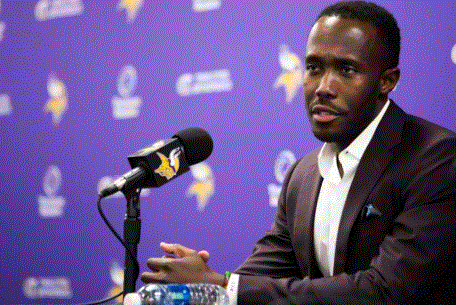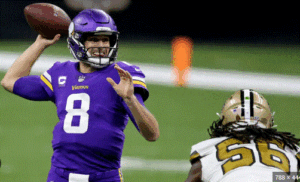
Minnesota Vikings’ Quarterback Outlook: Evaluating Options Behind J.J. McCarthy and the Anthony Richardson Trade Possibility
At present, the Minnesota Vikings are not in a state of desperation when it comes to finding a new quarterback. Their immediate focus remains centered on J.J. McCarthy, a promising talent whom the franchise hopes can emerge as a long-term solution under center. However, as McCarthy continues his developmental trajectory under head coach Kevin O’Connell, some analysts suggest that reinforcing the depth behind him could be a strategic decision — not out of necessity, but out of prudence.
As offseason speculation and roster evaluations unfold across the NFL, a new narrative has started to gain traction: the Vikings, despite already having a young quarterback in McCarthy, could explore trade options that position them for sustained competitiveness in the short and long term. ESPN analysts Ben Solak and Seth Walder recently offered trade ideas that involve Minnesota reacquiring veteran quarterback Kirk Cousins — currently with the Atlanta Falcons — by parting with backup quarterback Sam Howell or a conditional Day 3 draft pick, potentially accompanied by some financial considerations.
This trade idea, while intriguing, has more emotional than strategic pull for Minnesota fans. Cousins spent years with the Vikings and provided a steady hand at the quarterback position, though the team was often stuck in the gray area between wild-card relevance and true Super Bowl contention. A return to Cousins, who is clearly nearing the final chapter of his career, may serve short-term interests but would do little to secure the franchise’s long-term vision.
Looking Beyond Cousins: A Youth-Focused Approach
An alternative idea — and one that may be more compelling in the eyes of long-term roster architects — would be to take the same trade assets proposed for Cousins and redirect them toward acquiring a much younger signal-caller: Anthony Richardson of the Indianapolis Colts.
Richardson, who was selected fourth overall in the 2023 NFL Draft, was heralded coming out of college for his rare combination of athleticism, arm strength, and upside. However, his NFL career has been marred by early struggles, both in terms of performance and health. A shoulder injury limited him to just four games in his rookie campaign, and even when healthy, Richardson showed signs of difficulty adjusting to the speed and complexity of the professional game. His ball security, decision-making, and accuracy were all works in progress — to be expected of a raw talent with a limited college resume.
Despite those challenges, the ceiling remains high. This is precisely why the Vikings—a team already nurturing a young quarterback — may represent the ideal landing spot for a reclamation project like Richardson. Under O’Connell’s quarterback-friendly system and surrounded by a strong offensive unit including weapons like Justin Jefferson and T.J. Hockenson, Richardson could be afforded the kind of support system many young QBs lack.

Situational Turbulence in Indianapolis
The Colts, on their part, are undergoing a period of significant organizational uncertainty following the passing of longtime owner Jim Irsay in May 2025. The implications of this shift in leadership are still playing out, but it is widely speculated that the team may soon experience changes in both front-office personnel and coaching staff. General Manager Chris Ballard, who is now in his ninth year, is potentially on shaky ground after a stretch of middling results. Head Coach Shane Steichen, hired for his offensive acumen and quarterback development skills, currently holds a .500 record (17–17) and has yet to deliver a postseason berth.
Such instability makes it increasingly plausible that Richardson could be moved. Already, the Colts have sent a signal of limited confidence by signing quarterback Daniel Jones — most recently of the Vikings — to a one-year contract intended to challenge Richardson for the starting role. Jones, who himself has struggled to lock down a permanent starting job in his NFL career, would not pose a threat to Richardson under ideal circumstances. But if he does win the job, it could be an explicit acknowledgment by the Colts that they’re ready to move on from their 2023 top-five pick.
The scenarios under which Richardson could become available are multifaceted:
- Jones wins the starting job in training camp or early in the regular season.
- New ownership restructures leadership, replacing the coaching staff and front office, and chooses to start fresh with “their own” quarterback.
- Persistent performance issues or injuries cause the team to seek more consistency at the most important position on the field.
The Kevin O’Connell Factor
Minnesota’s potential interest in Richardson may go beyond pure analysis and strategy — it might also include a personal element. In a notable moment following the Vikings’ Week 9 win over the Colts in 2024, O’Connell sought Richardson out after the game and offered him heartfelt encouragement. While the quarterback hadn’t played that day — benched due to performance and coaching decisions — O’Connell made a point of telling Richardson:
“Hey, do me a favor and remember something,” O’Connell said. “You’re a bad dude, and you’re going to play a long time in this league. Go to work every day. Good things will happen for you. I still believe in you.”
That kind of affirmation speaks volumes about O’Connell’s view of Richardson’s talent and character. While a single interaction doesn’t necessarily predict future moves, it reveals mutual respect — and potentially a desire to work together under the right circumstances.
Why Minnesota Might Make the Move
The Vikings haven’t formally named J.J. McCarthy their starter for the 2025 season. McCarthy missed his rookie year due to a knee injury, and while the franchise is optimistic about his future, he remains unproven at the professional level. Adding a dynamic quarterback like Richardson could serve several purposes:
- Competition: Friendly internal battles can raise the performance of all quarterbacks on the roster.
- Insurance: If McCarthy doesn’t pan out, Richardson offers a high-upside fallback.
- Development: Both young quarterbacks could push each other, benefiting from a QB-centric coaching staff.
Additionally, the salary implications are manageable. Richardson has two years left on his rookie deal, totaling $34 million, and comes with a fifth-year option for 2027. This gives Minnesota flexibility while evaluating his fit and potential.
A Trade Scenario That Makes Sense for Both Sides
A trade package featuring Sam Howell — who could offer the Colts a serviceable backup or short-term starter — along with a late Day 2 or early Day 3 draft pick might be enough to entice Indianapolis if they believe Richardson’s time has run its course. From the Vikings’ side, it’s a relatively low-cost investment for a player with top-tier athletic tools and an outside chance of becoming a franchise quarterback.
Such a deal, if it materializes, would showcase Minnesota’s proactive approach to quarterback building — an acknowledgement that the most important position in sports cannot be left to chance or hope alone. The combination of competition, mentorship, and high-upside insurance could prove to be the best path forward.
Leave a Reply